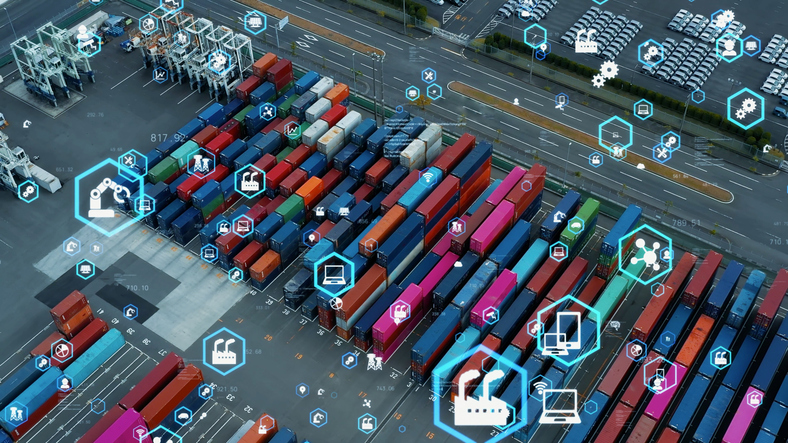How AI Is Used in Demand Forecasting
In an era marked by volatility and complexity, accurate demand forecasting is no longer just a strategic advantage; it’s a survival skill. For decades, supply chain professionals have relied on historical sales data, business intuition, and static models to predict future demand. But that approach is increasingly out of step with reality. With global disruptions, shifting customer expectations, supplier lead times, and SKU proliferation at an all-time high, businesses are demanding smarter, faster, and more responsive forecasting systems.
Enter AI demand forecasting: a transformative approach that enhances forecast accuracy, mitigates supply chain disruption, and delivers real-time insights that traditional methods simply can’t match.
This article explores how AI is reshaping demand forecasting, why it’s gaining momentum, and what supply chain leaders should consider when evaluating AI-driven solutions.
What Is AI Demand Forecasting?
Definition and Core Concepts
AI demand forecasting refers to the use of artificial intelligence technologies, especially machine learning algorithms, to analyze a wide range of data inputs, both structured and unstructured, to predict future product demand. These systems can process historical data, market signals, real-time data feeds, and external influences such as weather, economic indicators, or even social media trends. Unlike traditional methods that rely heavily on static models or planner intuition, demand planning with AI is dynamic, adaptive, and capable of learning over time.
Machine learning algorithms form the core of AI forecasting. These algorithms are trained on historical data to identify patterns and trends that might not be obvious to human analysts. Over time, they refine their predictions as new data becomes available, constantly improving their forecast accuracy. Methods such as time series analysis, regression modeling, and neural networks enable AI tools to recognize non-linear relationships and rapidly adjust to changing market dynamics.
Why Is AI Demand Forecasting So Important Today?
The rise of global supply chain complexity, heightened customer expectations, and shorter product lifecycles have pushed traditional forecasting methods to their limits. Companies can no longer afford to rely on static models or historical averages in a world where conditions change overnight. This is where AI demand forecasting excels.
AI enables businesses to transition from instinct-based planning to data-driven decision-making, incorporating real-time market signals and automatically adapting to changes in consumer behavior, weather, and economic activity. It’s particularly valuable in industries that experience seasonal fluctuations, promotions, or frequent new product launches.
This shift from rule-based to AI-driven forecasting empowers organizations to operate more proactively, reduce forecast error, and better align supply with actual demand. The result is not just improved accuracy, but greater agility and resilience across the supply chain.
To learn more about how forecasting methods are evolving across the industry, explore the 2025 State of the Supply Chain Industry report.
Traditional vs. AI-Driven Forecasting: What’s the Difference?
Limitations of Traditional Approaches
Traditional forecasting methods, such as exponential smoothing or ARIMA, often rely on static models supported by spreadsheets or basic ERP systems. These methods are rooted in historical data averages and manual planner adjustments, which makes them rigid and slow to adapt. When sudden market shifts or disruptions occur, such as tariffs, demand shocks, or geopolitical changes, these traditional tools are often caught off guard. Their inability to respond quickly reduces forecast accuracy and increases risk.
Furthermore, these models require significant human oversight and are prone to bias. The limitations in scale and flexibility make it difficult to process high-volume or real-time data, leaving organizations unable to capitalize on fast-moving market trends.
How Does AI Improve Demand Forecasting Compared to Traditional Methods?
By contrast, machine learning demand forecasting is designed to thrive in complexity. AI-driven systems use sophisticated models to analyze massive amounts of data, from historical trends and weather patterns to promotions and news headlines. These models recognize nonlinear relationships and learn over time, making them more accurate and adaptable than traditional tools.
One of AI’s most transformative advantages is its ability to introduce automation in forecasting. Instead of manual updates and adjustments, AI systems continuously ingest new data, refine their predictions, and surface anomalies or opportunities. This level of automation reduces operational burden while enhancing responsiveness.
The result is significantly improved forecast accuracy, allowing businesses to better align supply with real-time demand, reduce inventory costs, and improve customer service levels.
For more on how AI is driving this transformation, see Revolutionizing Supply Chain Planning with Machine Learning.
Key Benefits of AI in Demand Forecasting
Accuracy
One of the most widely recognized benefits of AI in forecasting is the significant improvement in forecast accuracy. By capturing subtle data patterns and dynamically adjusting to real-time variables, AI models routinely outperform traditional methods by 20% or more. This heightened accuracy enables better synchronization between supply and demand, helping companies prevent overproduction, avoid costly last-minute adjustments, and enhance customer satisfaction.
Automation
Another powerful benefit is the automation of repetitive and labor-intensive forecasting tasks. AI systems can automatically handle data ingestion, cleansing, model recalibration, and exception alerts. This automation leads to major labor savings and allows demand planners to shift their focus from manual number crunching to strategic analysis and decision-making. In an environment where skilled supply chain professionals are in high demand, this labor efficiency becomes a competitive advantage.
Inventory Optimization
AI also drives more precise inventory optimization by enabling companies to carry less excess stock while still meeting service-level goals. With more accurate forecasts, businesses can proactively address both stockouts and overstock situations. This leads to lower carrying costs, improved cash flow, and greater supply chain agility. For example, AI can detect early signals of a seasonal spike and adjust replenishment plans accordingly, long before the impact is felt.
Real Time Decisions
Perhaps one of the most transformative outcomes of AI forecasting is its ability to support real-time decisions across planning, procurement, and replenishment. AI models allow planners to get ahead of changing trends, account for promotion timing, and react instantly to changing conditions across sales channels. This level of responsiveness empowers organizations to be proactive rather than reactive, leading to fewer surprises and smoother operations.
To explore the advantages in more depth, visit Blue Ridge Demand Forecasting Solutions.
Industry Use Cases and Examples of AI in Demand Forecasting
The application of AI in supply chain forecasting is growing rapidly across a range of industries, from manufacturing to CPG to distribution. These sectors face constant challenges related to stockouts, overstock, and seasonal demand fluctuations, and AI helps mitigate these issues by enabling smarter, more agile forecasting.
Manufacturing
In manufacturing, long lead times and global supplier networks can complicate forecasting and planning. AI supports raw material planning by anticipating changes in demand and aligning procurement schedules accordingly. It improves supplier coordination through shared visibility and collaborative forecasting. For companies using make-to-order modeling, AI helps balance production schedules with real-time demand, reducing waste and optimizing capacity usage.
Automotive Distribution
In automotive distribution, forecasting demand is especially complex due to the breadth of SKUs, regional variability, and the lifecycle of replacement parts. AI helps distributors predict demand for aftermarket components by analyzing historical sales, regional vehicle registration data, seasonal repair trends, and even weather-related impacts. This allows companies to proactively stock the right parts in the right locations, minimizing backorders and costly rush shipments. AI also improves forecasting for new model releases and recalls, enabling faster alignment of supply with service center demand. With smarter, real-time planning, automotive distributors can reduce inventory costs while ensuring high service levels across their network.
CPG (Consumer Packaged Goods)
In the CPG space, maintaining high service levels while managing seasonal demand fluctuations is a constant battle. AI helps companies manage demand spikes tied to holidays, promotions, or media events. It improves shelf availability by dynamically adjusting store-level forecasts and ensuring timely replenishment. On the back end, AI improves supply planning by accounting for production constraints, transportation lead times, and retailer service requirements, all in one integrated forecast.
Other Sectors
Other industries are also tapping into the power of AI forecasting. In food and beverage, AI reduces spoilage by aligning inventory levels with perishability and lead times. In automotive, AI models forecast demand for replacement parts and accessories based on regional usage data. And in fashion, AI tools analyze emerging trends and social signals to forecast demand for specific styles, colors, and sizes across geographies.
AI’s adaptability and scalability make it a valuable tool across industries that struggle with stockouts, overstock, and highly variable demand patterns.
Choosing the Right AI Forecasting Solution
What Features Should AI Demand Forecasting Tools Include?
When evaluating demand forecasting software with AI, it’s essential to start with core capabilities that support day-to-day planning success. A user-friendly interface is critical so that planners across skill levels can leverage insights without needing technical expertise. Accessibility improves adoption and ensures teams act on the forecasts being generated.
Equally important is integration; your forecasting platform must connect seamlessly with ERP, WMS, TMS, and other supply chain systems to allow fast, cross-functional decision-making. The ability to automate data exchange cuts down on manual errors and lag time.
Transparency and explainability are vital in building trust in AI-generated forecasts. Decision-makers must understand why a forecast changed, what variables contributed, and how to interpret the outputs. Systems with built-in explainability empower teams to act confidently.
Finally, continuous learning models set the best systems apart. As market dynamics shift, the AI engine should adapt autonomously, without the need for constant human recalibration. This ensures long-term accuracy and relevance.
Evaluating Vendors
Beyond product features, selecting the right AI forecasting vendor involves a strategic lens. First, beware of black-box AI systems that deliver forecasts without transparency. If the platform can’t show its reasoning, it can’t be trusted during critical decisions.
Next, assess the vendor’s vertical expertise. Industry-specific experience improves model relevance, implementation speed, and support quality. A partner that understands your product lifecycle, seasonality, and customer patterns will deliver better outcomes.
Lastly, always evaluate ROI, both short- and long-term. Look for proof points like fewer stockouts, leaner inventory positions, reduced emergency shipments, and a measurable reduction in firefighting. Vendors should provide case studies or metrics showing their platform’s business impact.
For guidance on system selection, visit the Blue Ridge Supply Chain Planning System.
Is Your Forecasting Future-Ready?
Businesses that adopt AI in forecasting gain agility and resilience, equipping themselves to navigate supply chain disruptions with greater confidence and control. In a world where volatility is the norm, embracing AI isn’t just about keeping up, it’s about staying ahead.
With AI demand forecasting, organizations can shift from reactive fire drills to proactive planning, using AI-powered demand forecasting tools to drive better alignment between supply and demand, minimize risk, and boost customer satisfaction. These tools enable faster, data-backed decisions that improve forecast accuracy and streamline operations.
As more companies adopt predictive analytics, those who delay risk falling behind. The ROI is clear: fewer stockouts, leaner inventory, and more responsive supply chains. The question isn’t whether to implement AI, it’s how quickly you can put it to work.
Explore how Blue Ridge helps organizations modernize demand forecasting with AI:
FAQs: AI in Demand Forecasting
What is AI demand forecasting?
AI demand forecasting refers to the use of artificial intelligence in forecasting future product demand. It analyzes a wide variety of data sources, both structured and unstructured, to enhance prediction accuracy, adaptability, and responsiveness in demand planning processes.
How does AI improve forecasting accuracy?
AI improves demand forecasting accuracy by leveraging predictive analytics techniques such as time series forecasting, regression models, and neural networks. These models capture nonlinear trends and respond to real-time signals more effectively than traditional methods.
What industries benefit most from AI-powered demand forecasting?
Industries such as manufacturing, eCommerce, CPG, and food & beverage benefit significantly from supply chain optimization powered by AI. These sectors use AI to strengthen demand planning, reduce stockouts, and adapt quickly to market changes.
What data is used in AI demand forecasting?
AI forecasting relies on diverse demand data inputs, including sales history, POS transactions, promotions, weather, economic indicators, and social trends. These are processed using machine learning models to generate highly accurate predictive models.
Is AI forecasting better than traditional methods like ARIMA or linear regression?
Yes. Compared to traditional demand forecasting methods, AI offers better scalability and accuracy. Its ability to self-learn and handle complex variable relationships makes it more effective in the debate of AI vs. traditional forecasting.
How is AI used in supply chain management beyond forecasting?
In addition to demand prediction, AI supports supply chain planning activities such as inventory management, procurement, supplier collaboration, and logistics. The broader impact of AI in supply chain operations is a smarter, more agile network.
What are the biggest challenges when implementing AI demand forecasting?
Typical AI implementation challenges include poor data quality, difficulty with integration with ERP systems, and lack of in-house AI expertise. Resistance to change and unclear ownership of the forecasting process can also slow adoption.
What is the ROI of AI in demand forecasting?
The ROI of AI forecasting often includes a 20–40% forecast accuracy improvement, lower holding costs, and faster time-to-decision. Many companies report a measurable inventory cost reduction and improved service levels across their networks.















